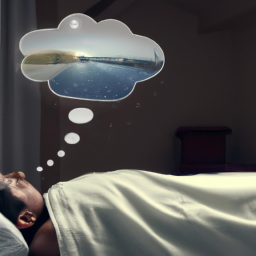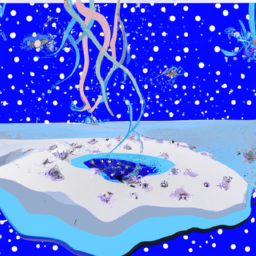Have you ever woken up from a dream and thought about how long it felt like it lasted? I certainly have. It’s fascinating to think that in just a few minutes, our minds can create entire universes, people, and events that feel so real.
Through research and analysis of scientific studies, I’ve learned about the fascinating world of dreams.
Dreams have been a topic of intrigue for centuries, with many cultures believing they hold significance in our lives. But what do we really know about them?
In this article, we’ll delve into the science behind dreaming and explore questions such as how long dreams actually last, their complexity, and their potential impact on mental health. So let’s dive deep into the world of dreams together and uncover some intriguing insights.
Key Takeaways
- Dreams occur during REM sleep stages.
- The average dream cycle lasts around 20-30 minutes.
- Our perception of time can be altered while we dream.
- Dreams provide an opportunity for our brains to explore various scenarios and outcomes without the limitations of reality.
Understanding the Science of Dreams
Understanding the science of dreams is key to figuring out how long they last. Dreams occur during the Rapid Eye Movement (REM) sleep stages, which happen several times throughout the night.
During these periods, our brains become highly active and generate vivid, complex experiences that we perceive as dreams. One aspect of understanding dreams involves interpreting their symbolism. Theories suggest that our subconscious minds use symbols in a way that speaks to us on a deeper level than just words or images.
These symbols often represent personal meanings related to our emotions and experiences. Interpreting dream symbolism can help us better understand ourselves by giving insight into unresolved feelings or problems we may be experiencing in waking life. With this foundation established, let’s dive into the duration of dreams.
The Duration of Dreams
You may be surprised to learn that the average person experiences around five dream cycles per night, each lasting roughly 20-30 minutes. These dream cycles occur during the stages of sleep, which are characterized by different brain waves and physiological changes.
The first stage is light sleep, followed by deeper stages in which the body relaxes further and breathing slows down. REM (Rapid Eye Movement) sleep is the final stage, during which most dreaming occurs.
During REM sleep, our brains become more active than they are during waking hours. This heightened activity leads to vivid dreams with complex storylines and surreal imagery. Despite the intensity of these dreams, they only last a few minutes at a time before transitioning into another cycle or stage of sleep.
However, our perception of time can be altered while we dream, making it seem as though we have been in a particular dream for much longer than we actually have. With this understanding of the duration and complexity of dreams, let’s explore how they can reveal insights into our subconscious minds without us even realizing it.
The Complexity of Dreams
Get ready to delve into the intricacies of dreaming and how our subconscious minds can reveal themselves through these complex experiences. Dream interpretation is a field that’s been studied for centuries, yet there’s still so much we don’t know about why we dream and what they mean. Here are four things to consider when exploring the complexity of dreams:
-
Dreams often have emotional significance: Many psychologists believe that dreams are a way for our brains to process emotions, particularly those we may not be fully aware of in our waking lives.
-
The content of dreams can vary widely: From vivid, surreal landscapes to mundane scenarios from everyday life, the range of experiences that can occur in dreams is vast.
-
The symbolism in dreams can be highly personal: While some symbols have universal meanings (such as falling representing a loss of control), others may hold specific significance based on an individual’s personal experiences and associations.
-
Dream interpretation isn’t an exact science: There are many theories about what different elements of a dream might represent, but ultimately, the meaning behind any given dream will depend on the context and personal experience of the dreamer.
As fascinating as these complexities are, it’s important to note that dreaming also serves an essential function in memory consolidation.
[Transition sentence into next section]Dreaming and Memory Consolidation
When your mind is in the state of dreaming, it’s not just about randomly processing information. In fact, one of the reasons why we dream is to consolidate memories and strengthen our learning. Dreaming and memory consolidation are closely linked as our brain replays experiences during sleep to reinforce neural connections that help us remember things better.
The process of memory consolidation occurs during different sleep stages and dreaming patterns. During non-REM (Rapid Eye Movement) sleep, the hippocampus processes new memories while the neocortex consolidates memories from previous days. However, when we enter REM sleep, which is characterized by rapid eye movements and increased brain activity, the hippocampus sends these consolidated memories back to the neocortex for further strengthening through dreams.
This means that if you were studying a new language before bed, your brain will replay those words during REM sleep to help you retain them better.
As we move on to discuss dreaming and problem-solving in the next section, it’s important to note how dreams can play a role in creative thinking and idea generation.
Dreaming and Problem Solving
Imagine your mind working on a problem even when you’re asleep, because that’s exactly what happens during dreaming. Dreaming and problem solving go hand in hand, with the brain using this time to process complex information and come up with solutions to problems.
But how does this happen? Firstly, it’s important to understand the role of emotions in dreams. Studies have shown that emotional content is more likely to be remembered than neutral content, which means that our brains are more likely to prioritize emotionally charged information when processing it during sleep. This is particularly relevant for problem solving, as emotions can help us evaluate potential solutions and make decisions based on their impact.
Additionally, dreaming provides an opportunity for our brains to explore various scenarios and outcomes without the limitations of reality, allowing us to think outside the box and approach problems from new angles. These factors combined make dreaming a valuable tool for problem solving and creativity.
Dreaming serves as a powerful resource for processing complex information and finding solutions to problems through its use of emotional evaluation and creative exploration. As we move forward into exploring the history of dream research, it’s important to keep in mind the crucial role that dreaming plays in cognitive functioning and innovation.
The History of Dream Research
You’ll be fascinated by the rich history of dream research, as scientists and philosophers have been exploring the mysteries of our dreams for centuries.
Dream interpretation has been a subject of interest for civilizations throughout history, including ancient Egypt and Greece.
In more recent times, Sigmund Freud’s psychoanalytic theory revolutionized the way we understand dreams. Freud believed that dreams were a manifestation of repressed desires, often sexual in nature. He saw them as a window into the unconscious mind, allowing us to uncover hidden thoughts and emotions. While his theories are controversial today, they had a profound impact on psychology and continue to influence dream interpretation.
As scientific methods advanced, researchers began using brain imaging techniques to study dreaming in more detail. But despite all these advancements, there is still much we don’t know about why we dream and what they mean for our psyche.
With such a long history of fascination with dreams across cultures around the world – from Native American tribes to Eastern philosophies – it’s no wonder that cultural differences in dreaming exist.
Let’s learn more about how different cultures interpret their nocturnal visions.
Cultural Differences in Dreaming
Exploring cultural differences in dreaming can offer insight into how different societies view the role of dreams in daily life. In some cultures, dreams are seen as a powerful tool for interpreting symbols and gaining insights about oneself and the world around them. For example, among indigenous cultures in Australia, dream sharing is an important part of socialization and spiritual practices. Dreaming is considered a way to connect with ancestors, receive guidance from spirits or deities, and gain knowledge about nature.
In contrast, Western culture tends to view dreams as mere figments of imagination or random firing of neurons during sleep. However, recent research has shown that even within Western culture there are variations in attitudes towards dreaming. Some individuals may see their dreams as sources of inspiration or creativity, while others may dismiss them altogether. Understanding these cultural differences in attitudes towards dreaming can help us appreciate the diverse ways people experience and interpret their dreams.
This understanding can also have implications for mental health professionals working with patients who report distressing or unusual dreams. By being aware of the patient’s cultural background and beliefs about dreaming, clinicians can provide more culturally sensitive care that takes into account the unique ways that each individual approaches their dream experiences.
Dreaming and Mental Health
Dreams can be a diagnostic tool for detecting and addressing mental health issues. Dream interpretation and analysis can provide valuable insights into our subconscious thoughts and emotions, which are often difficult to access in waking life.
By analyzing the symbols, themes, and emotions present in our dreams, we may uncover underlying psychological issues that require attention or treatment. For example, recurring nightmares or disturbing dreams may indicate the presence of trauma or anxiety disorders. Dreams that involve themes of loss or abandonment may signal feelings of grief or loneliness.
By examining these patterns over time, we can gain a better understanding of our own mental health needs and seek appropriate support from healthcare professionals. Dream analysis also allows us to explore our inner selves more deeply, leading to greater self-awareness and personal growth.
Moving forward into the subsequent section about lucid dreaming, it’s important to note that this type of dream state can also have significant implications for mental health.
Lucid Dreaming
As we’ve previously discussed, dreams can have a significant impact on our mental health. However, there are ways to take control of our dreams and use them to improve our overall well-being. This is where the concept of lucid dreaming comes in.
Lucid dreaming is when you become aware that you’re dreaming while still within the dream itself. This state allows for greater dream control, allowing you to actively participate in and shape the events of your dream. Many people use lucid dreaming as a tool for personal growth, such as overcoming fears or practicing new skills.
Studies have shown that lucid dreaming can also help alleviate symptoms of anxiety and depression by providing individuals with a sense of control in their subconscious minds. Additionally, researchers are exploring the potential uses of lucid dreaming in therapy and treatment for various mental health disorders. By harnessing this ability to consciously manipulate our dreams, we may be able to unlock new insights into the workings of the human mind.
Looking ahead to the future of dream research, scientists continue to delve deeper into understanding why we dream and how it affects our physical and mental health. With advancements in technology such as brain imaging techniques and virtual reality environments, we may soon have an even greater understanding and ability to explore the vast landscape of our dreamscape.
The Future of Dream Research
As a researcher in the field of dream science, I’m excited about the potential discoveries that await us in the future.
With advances in technology and imaging techniques, we may soon be able to gain a better understanding of the brain activity during dreaming.
This could lead to breakthroughs not only in neuroscience, but also in psychology, mental health, and even artificial intelligence.
As dream research continues to progress, it has the potential to impact society by providing new insights into human consciousness and unlocking new possibilities for therapeutic interventions.
Potential Discoveries in Dream Science
One can anticipate significant breakthroughs in the field of dream science. With the advent of new technologies such as functional magnetic resonance imaging (fMRI), researchers can now study brain activity during sleep and dreams with remarkable precision. This has led to an increased understanding of how different regions of the brain interact during dreaming, and how they contribute to our creative processes and emotional experiences.
For example, studies have shown that during REM sleep – a stage characterized by vivid dreams – there is increased activity in parts of the brain associated with emotion regulation and memory consolidation. This suggests that our dreams may serve an important role in processing and integrating emotional information from our daily lives. As we continue to explore these connections between dreams and emotions, we may uncover new therapeutic approaches for treating conditions such as depression or anxiety.
As we delve deeper into the mysteries of dreaming, advances in technology are helping us unravel even more secrets about this enigmatic state of consciousness. Through innovative techniques like lucid dreaming induction or virtual reality simulations, researchers are finding new ways to manipulate dream content and monitor brain activity in real-time. These developments hold great promise for unlocking further insights into the nature of consciousness itself – a topic that has fascinated philosophers and scientists alike for centuries.
Advances in Technology and Dream Research
You may be surprised to learn that there’ve been recent advances in technology that’re enabling dream researchers to uncover more about the mysteries of dreams. Dream tracking devices, for example, can now monitor brain activity during sleep and provide insights into what happens during different stages of sleep.
Virtual reality dream experiences are also being developed as a tool for exploring lucid dreaming and other aspects of the dream world. One promising technique is transcranial magnetic stimulation (TMS), which involves using magnetic fields to stimulate specific areas of the brain.
A recent study found that applying TMS during REM sleep can increase the frequency of lucid dreams by up to 50%. This has exciting implications for both scientific research and therapeutic interventions for conditions such as depression and anxiety. As we continue to develop new technologies and techniques, we may unlock even more secrets about the nature of dreams and their impact on our waking lives.
As we delve further into dream research, it’s important to consider how this knowledge will impact society at large. Understanding dreams could potentially lead to breakthroughs in fields such as neuroscience, psychology, and medicine. It could also open up new opportunities for personal growth and self-discovery.
In the next section, we’ll explore some potential applications of this research outside of academia.
The Impact of Dream Research on Society
The advances in technology have greatly impacted the world of dream research, allowing scientists to gain a deeper understanding of dreams and their functions. With the help of sophisticated brain imaging techniques such as electroencephalography (EEG) and functional magnetic resonance imaging (fMRI), researchers can now observe and analyze brain activity during sleep. This has led to groundbreaking discoveries about the nature of dreams, including their relationship to memory consolidation and emotional processing.
But how do these findings impact society? One area that has seen significant growth is dream interpretation and therapy. As people become more aware of the potential benefits of exploring their dreams, demand for professionals trained in this field continues to rise. Dream therapists work with clients to uncover the hidden meanings behind their dreams, helping them gain insights into their subconscious thoughts and emotions. This can be especially helpful for those struggling with anxiety, depression, or other mental health issues.
To illustrate further on how dream therapy works, here’s a table showcasing some common dream symbols and their interpretations:
| Symbol | Interpretation |
|---|---|
| Falling | Fear of losing control or failure |
| Flying | Sense of freedom or desire for escape |
| Teeth falling out | Anxiety or fear about appearance/communication |
| Running late | Fear of missing opportunities or being inadequate |
By analyzing common symbols within dreams, therapists can guide clients towards greater self-awareness and personal growth. Dreams are often seen as a window into our innermost selves – by learning to decode them, we may uncover valuable insights into our own lives.
Frequently Asked Questions
Can dreams predict the future or offer insight into past events?
Dream analysis techniques can provide insight into past events, but there is little scientific evidence to support premonition dreams. While intriguing, these experiences may simply be coincidental. As a researcher, I recommend skepticism and caution when interpreting dreams as predictors of the future.
What is the significance of recurring dreams?
Recurring dreams have symbolic meaning and can provide insight into unresolved issues. Therapy techniques such as dream analysis and interpretation can help uncover these meanings and aid in personal growth.
Do animals dream?
Animal brain activity during REM sleep suggests that animals do indeed dream. This has been observed in various species, from rats to dolphins. Further research on the content of their dreams is ongoing.
Can you control what you dream about?
Controlling one’s dreams is called lucid dreaming. Dream journaling can increase awareness and control of dream content. With practice, one can become skilled at shaping and manipulating the subconscious mind for self-improvement and creativity. Metaphorically speaking, it’s like painting your own reality.
Is there a connection between the content of dreams and personal experiences or emotions?
Dream content is often linked to personal experiences and emotions, as our brains use dreams for memory consolidation and emotional processing. This connection can have implications for mental health, making dream analysis a valuable tool in therapy.
Conclusion
Well folks, after diving deep into the science of dreams, it seems that the age-old question of ‘how long do dreams last?’ doesn’t have a one-size-fits-all answer.
The duration of dreams can vary depending on various factors such as sleep stage and individual differences.
But why stop at just determining dream length? We’ve also explored the complexity of dreams, their potential role in memory consolidation and problem solving, cultural differences in dreaming, and even the connection between dreaming and mental health.
And let’s not forget about lucid dreaming – the ability to control your own dreams. With all this fascinating research, who knows what lies ahead for the future of dream exploration.
Sweet dreams everyone!










